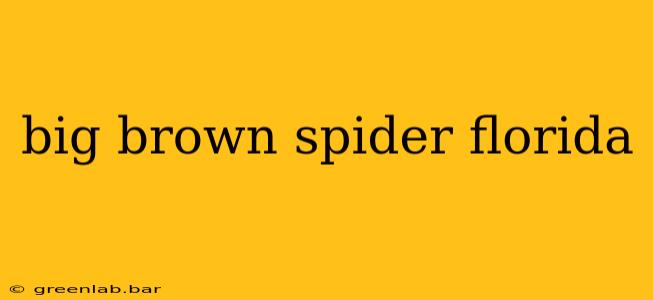Florida's warm climate makes it a haven for a diverse range of spiders, some quite large and brown. While many are harmless, knowing which species you're encountering is crucial for safety and peace of mind. This guide will help you identify common large brown spiders in Florida, understand their habitats, and learn how to react if you find one.
Common Large Brown Spiders in Florida
Several spider species in Florida could be described as "big brown spiders," leading to potential confusion. Let's explore some of the most frequently encountered:
1. Giant Crab Spider ( Heteropoda venatoria)
- Appearance: These spiders are easily identified by their large size (body length up to 1 inch, with a leg span of up to 4 inches), flattened bodies, and long, spindly legs. Their coloration varies, often a mottled brown or gray. They are often misidentified as other large spiders.
- Habitat: Giant crab spiders are common in homes, garages, and other structures. They prefer dark, damp areas. They are often found lurking in corners or behind furniture.
- Venom: While they possess venom, their bite is generally considered harmless to humans. It may cause a minor, localized reaction similar to a bee sting.
2. Wolf Spiders (Family Lycosidae)
- Appearance: Wolf spiders are hairy, ranging in color from light brown to dark brown or even black. They are robust spiders, often with distinctive markings. Sizes vary greatly depending on the species.
- Habitat: Wolf spiders are terrestrial hunters, found in various habitats, including gardens, fields, and sometimes inside homes. They don't build webs but actively hunt their prey.
- Venom: While they have venom, wolf spider bites are rarely dangerous to humans. They can cause mild pain, swelling, and itching.
3. Fishing Spiders (Family Pisauridae)
- Appearance: Large, brown spiders, often exhibiting dark brown and tan markings. They are frequently found near water. Their size is comparable to wolf spiders.
- Habitat: As their name suggests, fishing spiders are found near water sources like ponds, lakes, and streams. They are excellent swimmers and hunt near or on the water's surface.
- Venom: Like wolf spiders, their venom is not considered medically significant to humans; bites may cause localized discomfort.
Distinguishing Harmless from Potentially Harmful Spiders
While the spiders discussed above are generally not dangerous, it's essential to know how to differentiate them from potentially harmful species. The brown recluse and the black widow are venomous spiders found in Florida, but they have distinct characteristics:
- Brown Recluse: Recognized by a violin-shaped marking on its back, a uniformly brown color, and six eyes arranged in pairs.
- Black Widow: Easily identified by its shiny black body and a red hourglass marking on its abdomen.
If you encounter a spider that resembles a brown recluse or black widow, exercise caution and avoid handling it. Contact a pest control professional if necessary.
What to Do if You Find a Big Brown Spider
Most large brown spiders in Florida pose minimal threat. However, following these guidelines is advisable:
- Observe from a safe distance: Don't attempt to handle the spider.
- Identify the spider (if possible): Use the information above to try and determine the species.
- Remove the spider if necessary: Use a glass and a piece of stiff cardboard to carefully capture and relocate the spider outdoors.
- Seek medical attention if bitten: If bitten and experiencing severe symptoms like intense pain, swelling, or allergic reactions, consult a doctor immediately.
Conclusion
Understanding the types of large brown spiders found in Florida helps alleviate fears and promotes responsible coexistence. Remember, many are beneficial, controlling insect populations. Knowing when to exercise caution and seek professional help ensures both your safety and the spider's well-being. If you remain unsure about the identity of a spider, consulting a local entomologist or pest control expert is always a wise choice.

